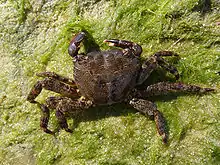Pachygrapsus marmoratus
Pachygrapsus marmoratus is a species of crab, sometimes called the marbled rock crab or marbled crab, which lives in the Black Sea, the Mediterranean Sea and parts of the Atlantic Ocean. It is dark violet brown, with yellow marbling, and with a body up to 36 millimetres (1.4 in) long. A semiterrestrial omnivore, it feeds on algae and various animals including mussels and limpets.
| Pachygrapsus marmoratus | |
|---|---|
 | |
| Scientific classification | |
| Kingdom: | |
| Phylum: | |
| Subphylum: | |
| Class: | |
| Order: | |
| Infraorder: | |
| Family: | |
| Genus: | |
| Species: | P. marmoratus |
| Binomial name | |
| Pachygrapsus marmoratus | |
| Synonyms | |
| |
Description
.jpg.webp)
P. marmoratus has a square carapace 22–36 millimetres (0.87–1.42 in) long, which is dark violet brown with marbling in yellow.[2] It can be distinguished from related species of Pachygrapsus in the Mediterranean Sea (Pachygrapsus maurus and Pachygrapsus transversus)[3] by the presence of three teeth on each side of the carapace.[2] It is capable of very rapid movements, and it uses this ability to dart into crevices, making it difficult to catch.[2]
Distribution
It is widespread in Southern Europe,[4] from the Black Sea to the Moroccan coast, and along the Atlantic coasts of Portugal, Spain and France,[5] and was observed as early as 1996 as far north as Southampton in the English Channel.[5] This range expansion may be due to the warming of the surface waters.[6]
Ecology
P. marmoratus is an omnivore, but not an opportunist; similar proportions of algae and animals are consumed however abundant they are in the habitat. The favoured animals in the diet of P. marmoratus are mussels, limpets and its own species.[4] When attacking the limpet Patella depressa, Pachygrapsus marmoratus uses a consistent method, which is usually unsuccessful.[7] On more sheltered shores, P. grapsus eats fewer mussels, but compensates with a greater consumption of barnacles.[8]
Predators of Pachygrapsus marmoratus include the musky octopus, Eledone moschata.[9]
The larvae of P. marmoratus are planktonic and may survive for up to 31 days. This results in high levels of gene flow between populations, and allows the species to rapidly colonise new areas.[10]
References
- Peter K. L. Ng; Danièle Guinot & Peter J. F. Davie (2008). "Systema Brachyurorum: Part I. An annotated checklist of extant Brachyuran crabs of the world" (PDF). Raffles Bulletin of Zoology. 17: 1–286.
- Rose Edwards (2005). "Pachygrapsus marmoratus: a marbled rock crab". Marine Life Information Network: Biology and Sensitivity Key Information Sub-programme. Marine Biological Association of the United Kingdom. Retrieved January 11, 2010.
- A. M. Vaccaro & C. Pipitone (2005). "First record of Pachygrapsus transversus (Gibbes, 1850) (Brachyura, Grapsidae) in Italian waters" (PDF). Crustaceana. 78 (6): 677–683. doi:10.1163/156854005774353511.
- S. Cannicci; M. Gomei; B. Boddi; M. Vannini (2002). "Feeding habits and natural diet of the intertidal crab Pachygrapsus marmoratus: Opportunistic browser or selective feeder?". Estuarine, Coastal and Shelf Science. 54 (6): 983–1001. doi:10.1006/ecss.2001.0869.
- Ray W. Ingle & Paul F. Clark (2006). "First reported occurrences of the marbled crab, Pachygrapsus marmoratus (Crustacea: Brachyura: Grapsoidea) in southern coastal waters of the British Isles" (PDF). JMBA2 Biodiversity Records. Archived from the original (PDF) on 2011-07-21.
- Jean-Claude Dauvin (2009). "New record of the marbled crab Pachygrapsus marmoratus (Crustacea: Brachyura: Grapsoidea) on the coast of northern Cotentin, Normandy, western English Channel". Marine Biodiversity Records. 2: e92. doi:10.1017/S1755267209001109.
- Ana Silva; Diana Boaventura; Augusto Flores; Pedro Ré; Stephen J. Hawkins (2004). "Rare predation by the intertidal crab Pachygrapsus marmoratus on the limpet Patella depressa". Journal of the Marine Biological Association of the United Kingdom. 84 (2): 367–370. doi:10.1017/S0025315404009294h.
- Ana Catarina Ferreira Silva; Sónia Brazão; Steve J. Hawkins; Richard C. Thompson; Diana M. Boaventura (2009). "Abundance, population structure and claw morphology of the semi-terrestrial crab Pachygrapsus marmoratus (Fabricius, 1787) on shores of differing wave exposure". Marine Biology. 156 (12): 2591–2599. doi:10.1007/s00227-009-1283-1.
- Halil Şen (2007). "Food preference of Eledone moschata Lamarck, 1799 (Cephalopoda: Octopodidae) in captive conditions" (PDF). International Journal of Natural and Engineering Sciences. 1 (2): 29–31.
- Inês C. Silva; Natacha Mesquita; Christoph D. Schubart; Maria Judite Alves; José Paula (2009). "Genetic patchiness of the shore crab Pachygrapsus marmoratus along the Portuguese coast". Journal of Experimental Marine Biology and Ecology. 378 (1–2): 50–57. doi:10.1016/j.jembe.2009.07.032.
External links
 Media related to Pachygrapsus marmoratus at Wikimedia Commons
Media related to Pachygrapsus marmoratus at Wikimedia Commons Data related to Pachygrapsus marmoratus at Wikispecies
Data related to Pachygrapsus marmoratus at Wikispecies